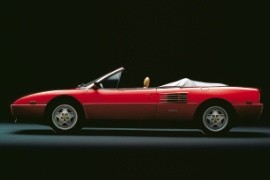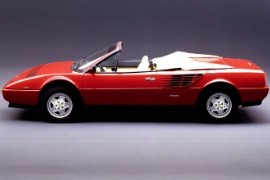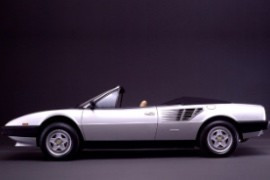FERRARI Mondial Cabriolet Models/Series Timeline, Specifications & Photos
First production year: 1983
Engines: Gasoline
Body style: Convertible (spider/spyder, cabrio/cabriolet, drop/open/soft top)
While its coupe sibling struggled with low-volume sales in the U.S., the cabriolet remained the only version of the Mondial available on the North American continent, continuing its glorious path of a four-speed luxurious supercar.
By 1989, the Mondial was already an old car. Still, it was one of the only options available for a four-seater, open-top supercar. Most other manufacturers couldn’t even get close to that performance, so Ferrari enjoyed the last glorious years for the Mondial T Convertible on the market. But still, it did that with significant improvements. While those from the outside were minimal, there were more consistent upgrades on the car’s interior and, most importantly, under the car’s skin.
Pininfarina Studio penned the car in the mid-70s, but the beautiful, timeless lines of the car were still attractive. So, Ferrari’s design center had the difficult task of making it look fresh again, and it successfully completed the task by adding colored-body bumpers adorned by a lower black spoiler at the front and back.
In addition, the stylists had to enlarge the car’s fenders to cover the wider track of the vehicle. But they couldn’t find a better solution for the retractable canvas top, which remained concealed under a fabric cover behind the cabin when folded down.
Inside, the leather-wrapped 2+2 cabin tried to provide enough comfort for adult-sized occupants. For the front occupants, the car provided just enough headroom and legroom, but the rear seats were mostly suitable for children. The automaker had to push the seats forward to make room for the retractable roof, and that affected legroom.
The redesigned instrument cluster offered a much better, well-organized layout with two large dials for the speedometer and rev counter flanking two gauges stacked between them for the oil pressure and coolant temperature. On the outer sides, the automaker placed the fuel level on the left and the ammeter on the right. Between the front occupants, on the flat center console, Ferrari placed an array of buttons for several car functions, such as the HVAC controls, the power antenna, and the parking lights. In addition, the automaker placed the gated gear stick lever on the forward part of the center console. On the center stack, Ferrari added the buttons for the suspension settings, power windows, and stereo. The latter was concealed behind a flip-down panel.
But the most significant change for the car was under the hood. There, the automaker reversed the engine and gearbox layout, placing the transmission in front of the V8 powerplant. As a result, the car’s weight distribution improved. Moreover, the engine gained a bigger displacement and produced 300 PS (296 hp) thanks to the advanced multi-point injection system.
Thanks to these improvements, the Mondial T provided better road behavior and improved acceleration times. Last but not least, Ferrari developed, together with the European manufacturer Bilstein, new dampers that could provide a stiffer or a softer ride at the touch of a button.
The Mondial Cabriolet was the first rag-top Ferrari since the Daytona, and it was introduced seven years after the coupe version. That was a long waiting time.
The Italian carmaker didn't rush to cut the roof of the Mondial. First, it introduced the coupe with a 3.0-liter. Three years later, after many complaints from its customers, that engine was upgraded to a four-valves per cylinder engine that finally made it moves faster. In 1985, the Prancing Horse brand introduced the 3.2-liter engine and the open-top version. Only 810 Mondial 3.2-cabriolet were produced.
Ferrari was already a respected brand in the supercar world and, thanks to its Formula One involvement, was worldwide known. Its beltline was unusually low, and its windshield unusually steps and tall for the car's size. At the front, the car kept the pop-up headlights that, when retracted, made the vehicle looks very stylish and streamlined. On its sides, behind the doors, the design team installed the air-intakes to cool the engine and soon become another specific element for the Italian brand.
Inside, Ferrari installed four seats. Thanks to its rear-engine construction, the Mondial featured enough room behind the rear seats to store the canvas top. But it was difficult to call the Mondial Cabriolet a true four-seater, since there was little legroom behind the front seats. At least, the carmaker garnished the convertible with luxurious amenities.
Under the hood, Ferrari installed a 3.2-liter V-8 paired to a five-speed manual gearbox. The new powerplant was an upgraded version of the quatro valvole, 1982 unit. It offered a higher power and lower fuel consumption.
Ferrari unveiled the Mondial Quattrovalvole Cabriolet in 1983, and it was the only four-seat convertible with a mid-engine on the market.
Ferrari was no longer considered only a sports car. It already became a status vehicle, which was luxurious and sporty alike. Even though it shared its engine with the 308, it couldn't match its sibling in terms of performance around a track. Thanks to the introduction of the open-top version, the Mondial became more popular in the U.S., where there was a high demand for performance convertibles, and other carmakers offered only T-top versions for their sports cars.
The Mondial Quattrovalvole featured the same front part as its coupe sibling. Its pop-up headlights followed the early '80s trend, and its integrated black rubber bumper was continued on the bottom by an apron meant to reduce drag. The design team managed to completely hide the fabric roof under a cover behind the rear seats.
Inside, Ferrari installed a leather-clad interior with similar details as the coupe. Yet, the rear seats were mounted closely due to the roof opening system. But usually, those two seats were seldom or never used for transporting people, but they made an excellent storage area for shopping.
Under the hood, the Italian engineers installed an upgraded 2.9-liter engine with four valves per cylinder (hence the Quattrovalvole). They paired it with the same five-speed manual gearbox. Only 629 units were made, transforming the Mondial QV Convertible into one of the rarest Mondials ever.
FERRARI Mondial Quattrovalvole Cabriolet 3.0 V8 5MT (240 HP)


